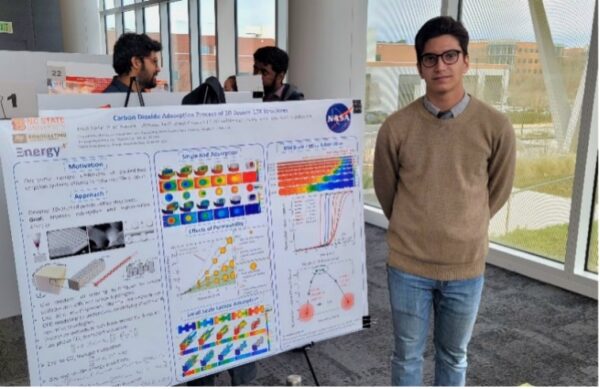 MAE doctoral student, Noah Agata, has been selected to receive the NASA Space Technology Graduate Research Opportunity (NSTGRO) fellowship award for his proposal on novel, nature-inspired, 3D printable carbon dioxide capture systems for space metabolic life support. The NSTGRO fellowship award is a potential four-year award at $84K per year. Agata is a Ph.D. student in the Energy eXploration Laboratory (Energy-X) directed by MAE Associate Professor Prof. Sajjad Bigham.
MAE doctoral student, Noah Agata, has been selected to receive the NASA Space Technology Graduate Research Opportunity (NSTGRO) fellowship award for his proposal on novel, nature-inspired, 3D printable carbon dioxide capture systems for space metabolic life support. The NSTGRO fellowship award is a potential four-year award at $84K per year. Agata is a Ph.D. student in the Energy eXploration Laboratory (Energy-X) directed by MAE Associate Professor Prof. Sajjad Bigham.
Sponsored by NASA’s Space Technology Mission Directorate, the NSTGRO fellowship supports ideas that show significant potential to contribute to NASA’s goal of creating innovative new space technologies for our Nation’s science, exploration, and economic future. NASA Space Technology Graduate Researchers will perform innovative, space technology research at their respective campuses and a NASA center. The visiting technologist experience is an integral part of an NSTGRO award, during which the NASA Space Technology Graduate Researchers perform their research at a NASA center each summer. Awards are made in the form of grants to accredited U.S. universities on behalf of individuals pursuing master’s or doctoral degrees, with the faculty advisor serving as the principal investigator.
Agata, Bigham, and their research group at the Energy-Exploration Laboratory (Energy-X) are currently working on the development of next-generation life support systems, to replace the current state-of-the-art technology with 3D-printed sorbent structures. They have developed a complex, multi-physics, computational fluid dynamic model that is capable of exploring the governing mechanisms of carbon dioxide adsorption and regeneration processes. Through this, optimization of topologies can be achieved, improving system performance and reliability while reducing system mass, volume, and power consumption. Under the proposed work, Agata will develop a holistic understanding of their printed structures, directly measuring material properties and constructing a benchtop breakthrough analyzer to further assist and improve the accuracy and capabilities of their modeling.
The goal is to optimize carbon dioxide adsorption and regeneration processes while simultaneously reducing pressure losses experienced by the air mixture. The team believes that an optimized sorption system can be realized by designing 3D sorbent structures with proper topology, material characteristics, and thermal conductivity. If successful, this project will advance the air revitalization system of NASA space vehicles for future Moon and Mars missions.